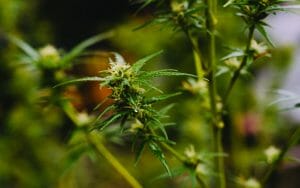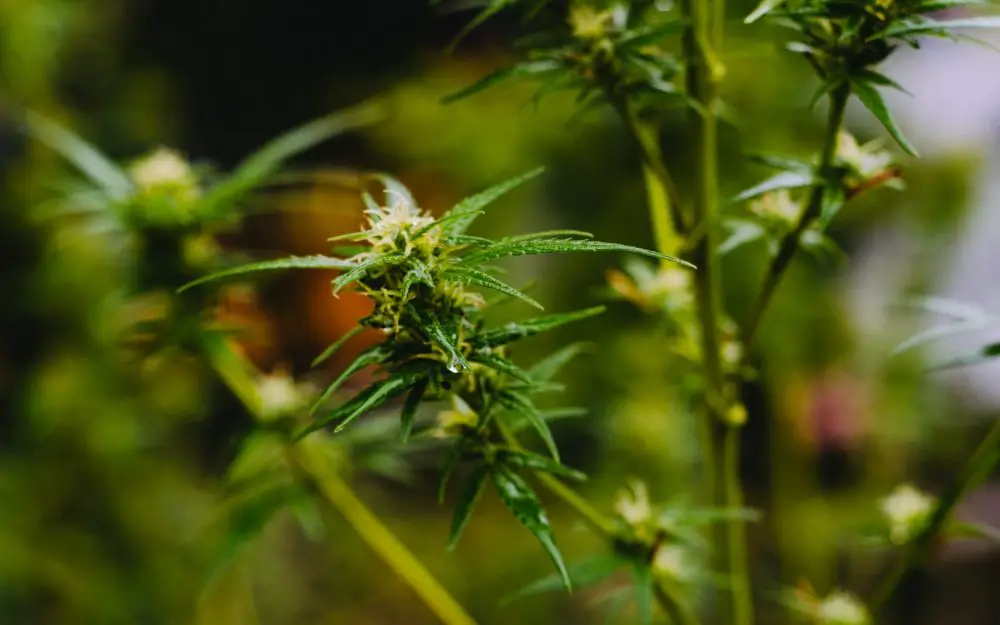Marijuana is an annual flowering plant, which means that it completes its life cycle (from germination, growth, flowering, and harvesting) in a single season. The dormant seed is the only part that survives one growing season to the next.

Once you harvest the marijuana buds, you are not likely to benefit from the weed plant’s unique properties unless you cloned it. But the life of a grower is filled with little-but-essential tasks that you can easily lose sight of your vegetating plant. Before you know it, it’s slipped into the flowering—behind your back— and now you might just lose your plant’s unique qualities.
Thanks to re-vegging, you can turn the course of your plant’s growth— take it back to the vegetative stage— and give it a second chance at life or get your cuttings. In this sense, re-vegging gives you a tight grasp on your unique crosses. But this is just a tip of the buds-berg.
Table of Contents
What Is Re-Vegging Cannabis?
Re-vegging is the process of reverting a weed plant from the flowering stage to the vegetative stage. The plant goes through a transformation that affects its growth patterns— the leaves will begin to grow with rounded edges, the nodes may also grow in an unusual pattern.
Every grower loves their ladies, and no grower would put a plant in the flowering stage through such stress if it had no benefit.
Reasons Why Growers Re-Veg Cannabis
Re-vegging gives you more control of what’s happening in the plant’s life— you can press rewind—thus, get all you need from the plant before you let it die. Most people re-veg cannabis so that they can have more than a single harvest from the same plant. Brilliant. Here are some more reasons why you should consider re-vegging cannabis;Adventures in re-vegging… took cuttings on Day 16 flower – quite late so wasn't sure how this'd go. Happy to say that regular vegetative growth has returned after 12 days under 20/4. Rooting took 10-12 days. Anyone else try this? They sure look weird!#GrowYourOwn #Cannabis pic.twitter.com/sSVZpsSI8a
— TempleGrower (@TempleGrower) July 1, 2020
To Preserve A Phenotype
Most people spend years trying different crosses to get their perfect strain. Breeding cannabis is a long, arduous process that only a few growers engage in. But once the perfect strain is secured, it must be protected so its unique quality can be maintained and replicated.
Growers can choose to grow their plants from either seeds or clones. But when you’re more interested in retaining the replica of your plant, cloning serves you best. Seeds from the same plant never give you the exact qualities of the mother plant— each develops a unique genotype— it is, therefore, impossible to replicate the exact qualities of the mother plant when you grow from seeds.
On the other hand, clones give the exact copy of the mother plant— It’s exact genetic makeup… all the extras in the mother plant. Cloning is the surest way to preserve unique phenotypes.
Unfortunately, cloning must be timed well for it to work in your favor. You must cut the clones when your plant is in the vegetative stage to get the best cuttings and give the mother plant enough time to heal before flowering.
You can get easily distracted by the everyday hassles of growing that the plants might get into flowering before you clone it.
Re-vegging allows you to bring the plant back to the vegetative stage so that you get your cuttings and preserve the unique qualities of the weed plant.
To Test the Sexual Stability of The Plant
Once the plant has hit the flowering stage, reverting it to the vegetative stage puts it through a lot of stress. Strains with hermaphroditic traits— growing both male and female sex organs— will bring out their true colors.
These aren’t the right strains to grow because any unexpected stress on the plant can considerably reduce your yield quality.
Taking the plant through re-vegging can be a good test for every grower to know sexually stable strains.
To Efficiently Use Space and Nutrients
Sometimes, growers keep the mother plant in the vegetative stage to directly cut the plant’s clones. This means the plant can’t produce any buds. But still, it takes up nutrients, time, and space in your grow room.
With re-vegging, you can cut your clones from any of the mother plant’s replica— and still, the plant will grow to produce healthy buds. You get both the buds and clones within a space that was once occupied by a mother plant that only gave the clones. Thus, you improve space efficiency because you only have bud-producing plants in your yard.
You also save big bucks on nutrients because you no longer have to feed the mother plant.
To Hasten the Growth and Maturity of The Plant
Re-vegging reduces the vegetative period massively since the plant has already developed a robust root system.
Unlike seeds that take time to germinate and clones that take longer to take root, when you regenerate a cannabis plant for a second harvest, it already has a working root system and some healthy flowers too. Thus, once it’s fully turned around, it grows way faster than plants grown from seeds or clones.
To Increase Yield
Monster cropping, which is the process of cutting clones from a flowering plant, can help you achieve great yields. The monster-cropped clone grows faster and bushier because it has more node points for bud growth. It also has sturdier stems and branches to support the numerous buds that grow from the nodes.
To Eliminate the Need for Seeds
The process of choosing the right seeds to plant is tedious and can waste valuable growing time. Re-vegging saves time by eliminating the need for seeds.
Growing from seeds come with a bunch of limitations. First, you have the 50/50 chance of growing male and female plants— you know how this goes, tedious! Unless you go for feminized seeds, you’ll have to go through the hassles of sexing your cannabis plants.
Besides, not every seed germinates. And if you don’t know the right germination techniques, you can waste your seeds and lose the growing game before you begin. Re-vegging eliminates the need for seeds.
Disadvantages of Re-Vegging Cannabis
Every good thing is accompanied by a bit of bad. Re-vegging has some disadvantages you should be aware of before doing it. These are;
- Difficulty in execution: While it may appear easy to perform in theory, it is hard to carry out the techniques, and you may need to practice before getting it right. As a beginner, you should stretch your growing knowledge to survive the plant through the stress of flipping it back to the vegetative stage.
- It’s hard to train re-vegged plants: Training cannabis is one of the best ways to increase yields. Without proper training, you lose yields of up to 40%. Weed plants that have been re-vegged are, however, harder to train since the plant has a firmer skeleton compared to that of a new plant.

Re-vegged cannabis plants have hard stalks, making them hard to train. Photo by Shane Rounce on Unsplash
- Reduced yields: While initial cycles of re-vegging gain better yields, doing it for more than two cycles result in less bud with every successive harvest. It’s beneficial, but don’t overdo it.
Cannabis Re-Vegging Techniques
Cannabis re-vegging can be done in many ways. While you’d love to be in control all of the time, sometimes the revegging process can begin without you trying. There’s a name for it— accidental re-vegging, and it happens when light leaks into your grow room and conditions the plant to pause flowering and vegetate again. Still, other re-vegging techniques give you more control of the process. Here are cannabis re-vegging techniques you might consider;
1. Post-Harvest Re-Vegging
This technique allows you to harvest your weed plant for buds and then regenerate it for a second growing season. It is easier because you don’t have to root cuttings—you’re just signaling the plant ‘to do it all over again’ and providing the resources to help it through the process.
How to Do Post-Harvest Re-Vegging
When you are harvesting, leave a few healthy flowers and branches at the base of the plant, as well as a few growth tips. Change the photoperiod cycle from the 12/12 light cycle you were using during flowering to the 20/4 light cycle. After ten days, when the plant has shown vigor in growth, you can tweak the light schedule to 18/16.
Change the plant’s nutrient regimen to one more conducive to early-stage growth. This means more nitrogen for root and leaf development. Transfer the plant into a larger pot and add fresh soil to promote root development further. You will notice that at the early stage, the re-vegged plant will exhibit stress-induced mutations like round leaves which will clear after a few weeks. Successful re-vegging will result in increased vigor, and once the plant turns full circle, it will grow faster.
Avoid overwatering after the harvest since the re-vegging plants need very little water as they revert to the vegetative state. Also, avoid taking too much flower when harvesting since the plant has a better chance of success with more leaves.
The benefits of this type of re-vegging are; you don’t have to plant new seeds, you save on vegetative time, and there is less trash since you don’t have to dispose of the harvested plant, and the plant grows back bushier.
The disadvantages are; the initial mutations worry many growers, and training the plant is more challenging since the plant has hardened stalks.
2. Monster Cropping
This technique involves taking cuttings from a flowering plant for cloning to preserve its genetics. Take cuttings from the lower part of the plant within the second and third week of flowering for best results.
Once you’ve made the cut, prune every pre-flower you find on the cutting. This will promote rooting. Just like the new leaves on a post-harvest re-vegged plant, the leaves produced by the clone from a flowering plant will first be deformed before adopting a conventional development. The clones also take longer to root. Removing all flowering nodes from a clone will improve its ability to root out.
3. Accidental Re-Vegging
Sometimes, the weed plant unexpectedly reverts to its vegetative state in case of lighting alterations. The tiniest change in the plant’s light cycle can cause a flip back from the flowering stage, with some plants even turning hermaphroditic. The various light schedule problems that can cause accidental re-vegging include;
- Light leaks in the flowering stage; when a weed plant is exposed to light during its 12-hour dark period, it is likely to re-veg.
- Timer issues; if the timer is not working correctly, it may give the plant light when it should be in its 12-hour dark period.
- Planting outdoors too early; planting weed outside at the wrong time of the year will expose it to lighting cycles that may force it to re-veg when the day gets longer.
In Conclusion
If done correctly, re-vegging weed plants can help you maintain the quality of weed you produce even when they have got into the flowering stage. It may need a little practice to perfect the art, but you can significantly benefit from it once you have mastered it.

